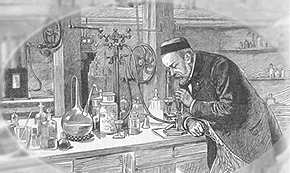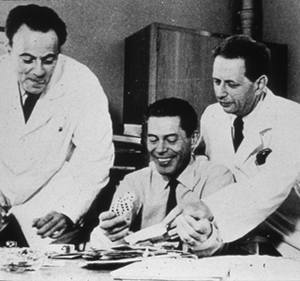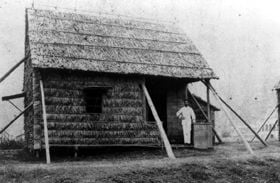
English
French
The Pasteur Institute was a product of Louis Pasteur’s victory over rabies; for vaccination against rabies represented just that for the entire world.
The great man of science is first and foremost one who is able to identify the right problems at the right time, when there is a possibility of finding a solution to them. He is also one who understands the importance of surrounding himself with gifted colleagues, is able to find amongst his students those who have the necessary qualities to succeed him and develop the theories he has put forward, the disciplines he has created.
 |
|
Louis Pasteur in his laboratory at the École Normale Supérieure. Print by Adrien Marie published in l’Univers illustré on December 2, 1885.
Copyright © Institut Pasteur |
Where Pasteur differed from everyone else, was that after having founded a new science and medicine, after having surrounded himself with a group of gifted researchers full of the same passion, he succeeded in installing his fellow-scientists in a working environment that was specifically designed to enable them to explore his ideas.
The Institute, set up in order to “treat rabies caused by a bite” by the method developed by Pasteur and his assistants, was built thanks to public contributions. Everyone participated; everyone gave their contribution; in every country; the poor as well as the rich; the postman of a market town in Normandy as well as the Tzar of all the Russians; a policeman from the Jura as well as the Emperor of Brazil; an anonymous poacher as well as the director of the Herald Tribune or the Bengal Regiment of Lancers.

The inoculation against rabies on the shepherd Jupille, bitten by a dog. First inoculation on 20 October 1885. Last inoculation on 30 October 1885. Inoculations were carried out in the Pasteur Laboratory at the Ecole Normale Supérieure, rue d’ULM in Paris.
Copyright © Institut Pasteur
 |
Inauguration of the Pasteur Institute on 14 November 1888. Copyright © Institut Pasteur |
The inauguration may have been prestigious, but the beginnings were very modest indeed. One single building for vaccination treatment and research work, and where Pasteur and his family were housed. There were five so-called “microbial” departments. Five scientists with very different training and personalities gathered around the Master: Duclaux, a renowned chemist; Chamberland, a professor of physics, Grancher, a doctor of medicine; Metchnikoff, whom Roux described as “this 45-year old from the heart of Europe, with an impassioned face, blazing eyes, untidy hair, definitely with the air of the demon of science”, and finally doctor Roux himself, the student so devoted to the Master.

Portrait of Metchnikoff who was awarded the Nobel Prize for Physiology or Medicine in 1908. Photo: by Ph. Nadar around 1900-1910
Copyright © Institut Pasteur
After Pasteur, Emile Duclaux ran the Institute; after Duclaux, Emile Roux. As these were the two colleagues who were closest to the founder, the Institute was run with the same style of leadership. Roux, who was a severe character, a sort of secular saint, reinforced this style of leadership by giving the Institute a sense of hierarchy, a slightly cold military aspect.
Lacking a family, looked after by the nurses of the Pasteur hospital, Roux had no other needs and could not imagine living in any other way. In his eyes, the honour of belonging to the House of Pasteur was beyond price. That was his justification for the modest salaries. This almost monastic devotion, which characterised Monsieur Roux, was for a long time, and often still is, considered as one of the traits of a model Pastorian.
 |
 |
| Portrait of Emile Duclaux, Director of the Pasteur Institute in Paris from 1895 to 1904. Photograph taken around 1880-1890. | Portrait of Emile Roux, Director of the Pasteur Institute in Paris from 1904 to 1933. |
| Copyright © Institut Pasteur | |
In the history of the Pasteur Institute are linked names and discoveries charting the development of biology and the struggle against some of the greatest scourges of humanity: the plague and Yersin; malaria and Laveran; typhus and Nicolle; diphtheria, Roux and Ramon; tuberculosis, Calmette and Guérin; the discovery of certain defence mechanisms, Bordet and then Oudin; bacteriophage, d’Herelle; sulphonamides, the Tréfouëls, Nitti and Bovet.
Since its creation, the Pasteur Institute has marked itself from other research and teaching bodies by certain distinctive features. First, its particular group of scientists. With the colleagues he first chose, Pasteur created a new type of researcher: “the Pastorian”. The Pastorian was recruited from all around the world. Sometimes he came from far afield, like for instance the great Elie Metchnikoff. With either a scientific or medical background, the typical Pastorian remained long on the periphery of official structures and of an official career. He was a doctor without a practice, a pharmacist without a dispensary, a chemist without an industry, an academic without a chair. His status was only defined by his style and above all by his place of work; he worked at the Pasteur Institute. With its diversity of scientific backgrounds and talents, all assembled in the same place there to study the same material from a wide variety of angles, the Pasteur Institute was really a centre for “interdisciplinary research” before the term even existed. Although Pastorians have subsequently acquired a certain status, the Institute has still retained its diversity, comprising researchers with varied backgrounds as well as many foreign trainees.
The close links maintained between research and application are another distinctive feature of the Pasteur Institute. Perhaps no one knew better than Pasteur how to unite these two aspects of science. Pasteur incorporated this union into the structure of his Institute; research gave ideas to industry which in return supplied the funds for research. If the Pasteur Institute did not become the leading centre of the biological industry in Europe, it is mainly because the Pastorians themselves displayed little gift for, or interest in business and industry. However, it was also due to the fact that private industry gave them little support. Hence the financial difficulties the Pasteur Institute experienced after the Second World War. Up until then the Institute had survived on its own resources.

From left to right: François Jacob, Jacques Monod and André Lwoff, who were awarded the Nobel Prize for Physiology or Medicine in 1965. Jacques Monod was director of the Pasteur Institute in Paris from 1971 to 1976.
Copyright © Institut Pasteur
In 1974, the authorities had the good sense to grant the Institute an annual subsidy corresponding to half of its budget, though the Institute maintained its status as a private foundation. At the same time, at the instigation of Jacques Monod, the Institute’s then director, production was separated from research, and is today closely linked to two powerful pharmaceutical concerns. By keeping its status as a private foundation in this way, and especially thanks to a number of donations and legacies, the Pasteur Institute has been able to maintain its flexibility, its ability to react to the unexpected in research, something public bodies are all too often unable to do.
The final distinctive feature of this Institute was its ability to spread throughout the world. For the history of this House is not only a long list of discoveries, nor is it only a list of names, famous or otherwise, of all those researchers or engineers, assistants or technicians, workers or laboratory assistants who slowly, patiently participated in the work, and made the Institute what it is today. It is also all those scientists who, after having trained at the Pasteur Institute, were scattered across the globe to study the most widely differing diseases in the field, and who, on the spot, established centres which operated according to the principles they had been taught in Paris.
 |
| Emile Roux and Alexandre Calmette, Director of the Pasteur Institute in Lille from 1895 to 1919. Copyright © Institut Pasteur |
In effect Pasteur extended his field of action overseas. He dispatched one of his first students, the young military doctor Albert Calmette, to the Far East to combat rabies and smallpox. Calmette set up a laboratory in Saigon to prepare vaccines. Immediately, people who had been bitten and risked getting rabies, flocked from everywhere, from Siam, Java, Singapore, Tonkin, even Japan. In less than two years, Calmette inoculated nearly 500,000 people.
The branch in Saigon was only the first of a whole constellation of Pasteur Institutes overseas. From Tahiti to Cayenne, through southern Asia, the African continent and around the Mediterranean, many of these institutes have, despite political trials and tribulations, retained their links with the maternal foundation. Thanks to these institutes, Pastorians have had and still have direct access to the study of tropical diseases.
The Pasteur approach has been used in these overseas institutes, in the same spirit, with the same sure judgement. Take Alexandre Yersin as an example. Yersin was a rather extraordinary character from Switzerland, who as a young man went to study medicine in Paris. There he very soon started working with the Pasteur team, first at the École Normale, and then at the Institute after the building was completed. As Roux’s assistant, he worked with the latter on diphtheria, and he proved the existence and the role of the “poison”, the first known toxin. However, this solitary man yearned for escape, for the sea, longed to travel. So he engaged himself as a doctor on one of the Messageries Maritimes vessels and then explored all Indochina.
During that time, a plague epidemic broke out in China and Indochina. The French government instructed Yersin, the former Pastorian, to go to the area of the epidemic to study the plague and find a cure. Yersin set to work in a bamboo hut covered in straw in Hong Kong, in rather difficult circumstances due to the lack of goodwill on the part of the British authorities and the hostile competition from a team of Japanese microbiologists. In a few days, he triumphed over his Japanese rivals, isolated the plague germ and showed the role rats play in epidemics.

A. Yersin in front of his hut in Hongkong. He was director of the Pasteur Institute in Nha Trang from 1895 to 1943.
Copyright © Institut Pasteur
Back in France and at the Pasteur Institute, Yersin prepared an anti-plague horse serum which protected rabbits, rats and mice. He then returned to China where the epidemic had flared up again with a vengeance. It was there that the first human trial was carried out, on a young Chinaman who, badly smitten by the disease, was already prostrate and feverish. Yersin began his inoculations. Within a few hours, a miracle occurred. The fever subsided. The patient could rest, cured. It was the same dramatic success as ten years earlier when Pasteur first treated rabies.
 |
| Satirical drawing of Pasteur and rabies which appeared in Le Grelot on August 8, 1885. Copyright © Institut Pasteur |
The Pastorians did not hesitate to step beyond the strict boundary of infectious diseases, when the opportunity presented itself. At the Saigon Institute, founded during Calmette’s first mission, the first research on snake venom was carried out. This is what Calmette said on the subject: “During the month of October 1891, in the rainy season, the Bac Lien village, which lies in lower Cochinchina, was attacked by a swarm of venomous reptiles belonging to a species known as the Capel Cobra. This is none other than the Naja whose peculiar habits Rudyard Kipling described so well in The Junglebook. These animals, which had penetrated right into the native huts, had bitten four people who died within hours. An Annamite, pursuing his profession as a “psylle” or “snake charmer” in the region, was able to catch 19 of these cobras and shut them up alive in a barrel. The local authorities decided to turn to the Pasteur Institute in Saigon, where it was decided that this was an excellent opportunity to resume the study of a specimen in which there was much interest following the discoveries of Emile Roux and Behring on toxins and anti-toxins”. This research was to lead to antivenom serotherapy. It still has repercussions on some of the research carried out today at the Pasteur Institute.
Pasteur’s work took microbes out of the ghetto in which they had been enclosed since their discovery by Leeuwenhoek. The world of microbes had finally found their place at the heart of the living world. And, within a few years, mankind was surprised to learn that the world would not have been the same without microbes. However, because of their small size, their lack of structure and peculiar behaviour, microbes remained a thing apart from other organisms. Moreover, their importance as pathogenic agents, their function in the cycles of the transformation of the elements, their role in a number of industries long prevented them from being studied in their own right, for their own properties. It was not until the thirties that physiologists and biochemists finally centred their research on the biology of microbes and linked it to that of other organisms.
Once again it was a Pastorian who put forward the strongest argument demonstrating the unity of the living world. By studying the nutrition of bacteria, André Lwoff analysed the role of growth factors, the compounds which are necessary if certain bacteria are to multiply, just as vitamins are needed for the growth and health of mammals. Lwoff was able to show that these growth factors, required only by certain organisms, are in reality the constituents of all living beings; that they are essential to all life. If some organisms require these factors in their diet while others do not, it is only because the latter produce these compounds themselves whereas the former are incapable of doing so. This was an immensely important discovery. It showed that the same structures and the same functions can be found in all living beings; that the whole living world is made up of the same material. A few years later, the analysis of the nutrition of micro-organisms based on Lwoff’s ideas, was resumed by geneticians. Thus biochemical genetics was born.
From then onwards the situation was reversed. Far from being quite separate from other organisms, bacteria became the material of choice in the study of cells, their functions, their syntheses. The circle had thus been closed. Pasteur’s journey took him from crystallography and the study of tartrate molecules to the living world and microbes. Molecular biology is taking the reverse course and, with bacteria as the point of departure, studying the structures and functions of the main molecules that make up organisms. In the developments of molecular biology which in a few years will change our conception of the living world and penetrate the different aspects of biology and medicine, the Pastorians, with the teams of André Lwoff, Jacques Monod, François Jacob, Elie Wollman, François Gros and Jean-Pierre Changeux, will play an important role. Thus one century after the discovery of vaccination against rabies, it was once again at the Pasteur Institute that Montagnier, Barré-Sinoussi and Chermann isolated and identified the HIV virus responsible for one of the greatest curses of our times.
Just over one hundred years since it was founded, the Pasteur Institute has today over 500 researchers and 600 trainees. It has nine research departments and 70 units in fundamental research fields and in the sphere of public health. Pasteur was certainly right to think on a grand scale.
Translated by Louise Ratford.
Acknowledgement
Photos were kindly provided by Institut Pasteur.
First published 2 April 1998